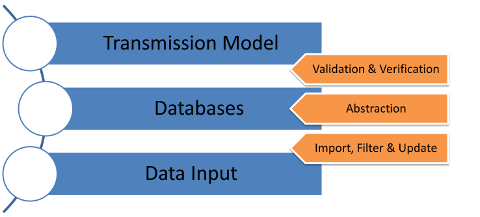Motivation and Approach
As of today, only limited data of the structure of the European transmission networks is publicly available for research and related purposes. The lack of such data renders attempts to verify, compare and validate high resolution energy system models a hard if - in parts - not even an impossible task.
Motivation and aim
Details of the transmission network are currently integrated in a number of in-house energy system models which are not publicly available. The assumptions, simplifications and the degree of abstraction involved in the transmission network models used are, hence, unknown and often undocumented. This fact implies, that the learning curve in the construction of grid models is rather low, since there is hardly any (scientific) discussion on the underlying approaches, procedures and results. At the same time, the output of energy system models takes an important role in the decision making process concerning future sustainable technologies and energy strategies. Recent examples of such strategies are the ones under debate and discussion for the Energiewende in Germany.
In this framework, the SciGRID project initiated by the research center NEXT ENERGY aims at building an open source model of the European electrical transmission network. Releasing SciGRID as open source is an attempt to make reliable data on the transmission network available. Appropriate (open) licenses attached to transmission network data ensures that established models and their assumptions can be published, discussed and validated in a well-defined and self-consistent manner. In addition to the transmission network data, the methods developed for building the model SciGRID are published under the Apache 2.0 license.
The main purpose of SciGRID is hence to open the door to new transmission network models and ideas in energy system modeling by providing freely available and well-documented data on the European transmission network.
Technical approach
On the technical level, the SciGRID model is written in a modular fashion using Python and SQL commands, and is mainly based on the "power" relations data available in openstreetmap.org under the Open Database License (ODbL). OSM power data constitute the skeleton of the SciGRID model. In the SciGRID model, the "power" relations from OpenStreetMap (OSM) are filtered and exported to relational databases where they are used to build an abstracted transmission network. The relational database approach allows for a flexible and a modular structure of the SciGRID model. For example, only networks with transmission lines of a certain voltage level, managed by a certain network operator, or for a certain type of cables can be filtered and graphically displayed.

On the pure scientific level, the validation of the network model will be performed and the insuing model will be compared in a first step to reference data, e.g. to maps available from ENTSO-E. In the framework of SciGRID, new and innovative methods to spatially and statistically evaluate and characterize network models are going to be developed along with GIS-based tools for the visual comparison of different network models and structures.
OpenStreetMap
OpenStreetMap can be visualized directly as a map and the underlying data is exported in XML format which follows a certain schema definition. OSM data is based on three data types, called data primitives, which are nodes (defining points in space), ways (defining linear features and area boundaries) and relations (defining logical or geographical relationships between other elements). The data set relevant for the power grid are filtered using the power tag, which is used to identify a wide range of facilities and features which relates to the generation, the transmission and the distribution of the electrical power. A map of OpenStreetMap data showing in particular power-related details can be found here.
For the case of a 3 phase electrical transmission system, 3 cables define a circuit, which are represented by "power" relations in OSM having the key "route" and value "power". The "power" relations sub-tags define the components of the transmission circuits, which are the substation(s) and transmission line(s). Other sub-tags provide technical details about the components of the transmission network as: the tag voltage indicates the voltage level of a transmission line or a substation, the tag cables indicates the number of power-carrying cables represented by a transmission line, and the tag tower to represent the towers or pylons carrying the electricity cables.
To construct the SciGRID model using OpenStreetMap data, the transmission network components need to be accurately and correctly defined, isolated and reproduced in a consistent and an automatized fashion. The SciGRID transmission model is currently based on using the "power" relations, more information about the SciGRID usage of "power" relations are available here.
For more information about the technical approach and the different tools used in the SciGRID model, please refer to the SciGRID v0.2 User Guide.
